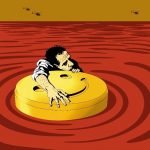MDMA Can Cure PTSD: An Interview with Dr Stephen Bright

Most Australians think of MDMA as the illicit party drug ecstasy. Often it’s the main ingredient. However, an ecstasy pill will usually contain a range of substances, such as PMA, which mimics the effect of MDMA, but can be much more dangerous.
Public perception of MDMA has become rather negative over recent years, after a spate of deaths at music festivals has been associated with the drug. But pure MDMA – taken at a correct dosage – is one of the least dangerous illicit drugs known, and it’s not prone to overuse.
While the use of medical marijuana to treat chronic pain and extreme epilepsy is now widely accepted, there’s less awareness of the medical benefits of MDMA.
The US is close to approving prescription MDMA
For years now, researchers have been looking into how MDMA can be used in conjunction with therapy to help people suffering post-traumatic stress disorder (PTSD).
The US Food and Drug Administration (FDA) announced last week that it’s approved large-scale trials into the drug’s use in treating trauma. These are stage 3 trials, which are the final step before MDMA is possibly approved as a prescription drug.
PTSD is an anxiety disorder people develop after experiencing a traumatic event. About 25 percent of people who live through such an event suffer the disorder.
In the States, MDMA-assisted psychotherapy has been used to cure war veterans of the condition, when pre-existing treatments haven’t worked.
The Multidisciplinary Association for Psychedelic Studies (MAPS) is funding the coming trials, which will include around 230 patients. This small nonprofit advocates for the legal medical use of MDMA and other psychedelic substances.
Calls for Australian trials
There have been attempts to mount a similar small-scale trial in Australia to treat war veterans. But these attempts have been blocked.
And there’s a dire need for these trials in Australia. According to charity Walking Wounded, since 1999, 239 veterans have committed suicide, compared with 49 killed while on active duty.
Existing treatments aren’t working for these people. And there’s no access to this alternative treatment that’s been proven to work elsewhere.
Psychedelic Research in Science and Medicine (PRISM) is the group behind the push for the Australian trial. Established in 2011, PRISM is also advocating for a psychedelic science program in Australia.
Dr Stephen Bright is a clinically-trained psychologist from the School of Psychology at Curtin University. He’s also PRISM’s vice president.
Assisted psychotherapy
Dr Bright stresses that treatment MDMA is administered in the context of psychotherapy. It’s not simply given to someone and they get better. Typically, a male and female therapist team administer the drug.
Prior to the MDMA session there’s a preparatory session. And afterwards there’s an integration session and that’s the most important part of the treatment. It helps the patient process what they’ve experienced and integrate it into their daily life.
Sydney Criminal Lawyers® spoke with Dr Stephen Bright about the benefits of MDMA-assisted psychotherapy and how Australia needs to invest in psychedelic research.
Dr Bright, we’ve all heard of post-traumatic stress disorder. But from a psychologist’s point of view, how do you describe it? And what leads people to suffer it?
PTSD is a debilitating condition that can emerge in people who are exposed to an event in which their life is placed in danger, or even witness such an event. For example, being sexually assaulted, a motor vehicle accident, bush fires or military combat.
Developing PTSD is not a sign of psychological weakness. It’s the body responding to the over-activation of the fight or flight response, so the event becomes imprinted in the emotional centres of the brain.
People experience a sense of hyperarousal, so they’re always in that fight or flight mode, which can lead to feelings of anxiety and aggressive behaviours.
Consequently, they become hypervigilant to danger and this often leads to avoidant behaviours, such as not leaving the home or using alcohol or other drugs to numb their emotions.
They also often re-experience the event either while they’re awake or in nightmares.
How is PTSD treated today? And why is there a need for different treatment options?
The first line treatment is exposure-based cognitive behavioural therapy. The aim of this treatment is to assist the person to reprocess the trauma, so that the memory of it is stored in the part of the brain, alongside other normal life memories. And not in the emotion centres of the brain.
It involves the client re-experiencing the traumatic event through a graded hierarchy in which they start with talking about the event in the third person and then at the end engage in imaginal exposure of the event that involves describing smells, sounds and other sensations.
The aim is for the client to be working within the window of distress tolerance, which is optimal for reprocessing the trauma. It can’t be too overwhelming or the client will drop out of treatment. Some clients will engage in strategies to avoid experiencing enough distress and that makes the treatment ineffective.
This can take up to 18 sessions. It’s hard work for both the client – who has to listen to the recorded session in between – and the therapist, who has to hear the person’s horrific story over and over again.
There are other treatments like eye movement desensitization and reprocessing (EMDR) and cognitive processing therapy, but they essentially involve the client re-experiencing their trauma and looking for opportunities to reframe it. For example, helping a client with survivor’s guilt realise that there is nothing they could have done to prevent the other deaths.
For some people, this treatment can be a cure, but others don’t respond to it.
If people don’t respond to one of these treatments, then they’re usually placed on antidepressant medication, which typically only provides mild alleviation of the symptoms.
It’s a bit like putting a band aid on a wound that needs stitches. And the person’s required to take the medication for the rest of their life.
Most people with PTSD that take antidepressants say it provides little relief. And they’ll often turn to alcohol and other drugs to try and manage their symptoms.
While others, tolerate the symptoms and then suicide.
Last week, the United States FDA gave approval for large-scale clinical trials of MDMA to treat PTSD. This could lead to it becoming a prescription drug. Most of us in Australia only know of MDMA as the party drug ecstasy.
How can MDMA be used to treat PTSD? Why is it an effective treatment?
It’s important to distinguish between MDMA and ecstasy. Ecstasy is the recreational drug that may or may not contain MDMA. The MDMA used in clinical trials is pharmaceutical-grade MDMA.
Similarly, it’s important to distinguish between the therapeutic use of MDMA, where there’s the intention of healing, versus recreational use, where the intention is to have fun.
Perhaps in a clinical setting MDMA should be called “empathy” instead of ecstasy, as this is one of the key features of MDMA that makes it therapeutic. It leads the client to have significant trust for the therapists, so that they feel safe enough to be comfortable talking about their trauma and other issues.
MDMA therapy occurs in the context of psychotherapy. There are sessions to prepare for the MDMA session. And then integration sessions that follow to consolidate the information that emerged during the MDMA session into everyday consciousness and life.
The MDMA allows people to be more emotionally open, so that they’re able to talk about their trauma within the window of tolerance. Many clients report going deeper into their traumatic experience in their first MDMA session, than they have ever gone before.
As one client, who was an Iraq war veteran, put it: “It feels almost like the inner healer or the MDMA is like a maid doing spring cleaning. It’s as if you thought you were cleaning before, but when you got to things you didn’t really want to deal with, you’d just stick them in the attic. If you’re going to clean the house, you can’t skip the stuff in the attic.”
Perhaps what’s more remarkable in MDMA sessions, is that many clients spontaneously engage in reframing and identifying the dysfunctional cognitive processes that they’ve been engaging in that have been perpetuating their PTSD. MDMA seems to be a catalyst for the psychotherapy process.
Dr George Greer – who was provided with MDMA-assisted psychotherapy – says that discovering MDMA was akin to a painter who only had charcoal discovering colour paints.
What sort of symptoms can MDMA alleviate? How does the treatment work?
The aim of MDMA-assisted psychotherapy is to cure the person of PTSD.
In the first completed study since MDMA was made an illegal drug – which was conducted in the US – 20 people who hadn’t responded to at least two evidence-based treatments for PTSD were randomised to either a control condition, where they received a placebo, or the active condition in which they received 125 mg of MDMA.
At the end of the treatment, 83 percent of participants in the active group no longer met DSM-IV criteria for PTSD.
The control group who had only received a placebo during the sessions were then offered the opportunity to have MDMA and undergo the MDMA-assisted psychotherapy again.
These effects – which are significant given that these people hadn’t responded to other evidence-based treatments – were maintained at a three and a half year follow-up, with only 10 percent of participants relapsing.
What sort of research has been done into the use of medicinal MDMA?
There have been phase 2 clinical trials conducted in South Carolina, Colorado, Canada, Israel and Switzerland. These studies have all been randomised controlled trials, which are seen as the most rigorous scientific methodology for evaluating the effectiveness of a treatment.
Over 100 patients have taken part in these trials. There are now trials looking at the use of MDMA to assist people with autism improve their skills in connecting with others in a social context at UCLA.
Further, a study has recently commenced in the UK that aims to treat people with alcohol and other drug problems with pre-existing trauma using MDMA-assisted psychotherapy. This treatment is also being examined to alleviate anxiety among people with terminal illness in California.
You’re one of the people who’ve been pushing for a small scale trial in Australia to treat war veterans. How would this work? And why the focus on veterans?
We want to focus on war veterans as more military personnel are killing themselves, than have died in recent combat. Between January and August this year alone, forty one soldiers suicided. Forty one Australian soldiers died in the entire war in Afghanistan.
This is a critical situation that needs to be addressed and we’ve received some support from the RSL.
The trial would recruit 12 war veterans with treatment-resistant PTSD following the same protocol that has been used in the trials overseas.
Where’s the resistance to the trial coming from? Is the illegality of MDMA a reason why the authorities are blocking these trials? What if we were talking about another chemical substance that didn’t have a street value?
Primarily we have encountered academic conservatism.
We have twice submitted the study. In the first instance it was to an independent ethics committee who didn’t have a problem with the idea of giving MDMA to people with treatment-resistant PTSD given the evidence that was emerging at the time – though they felt that the study would be better conducted within the context of an institution.
Consequently, we recently submitted the protocol to a Melbourne university, where one of our members has an academic position. However, the head of the university rejected the proposal outright – before it even made it to the university’s ethics committee.
Australia is a small country and there’s limited government funding for research. Almost all the money that’s provided to investigate illegal drugs is for research that demonstrates the dangers associated with them.
As such, I think that some Australian researchers are scared that if they support this research, then it could impact on their future funding.
In saying this, it’s worth noting that MAPS – the sponsor of the phase 2 studies previously described – were able to bypass phase 1 trials to establish safety by using the 100 million dollars’ worth of research conducted by the US National Institute of Drug Abuse that had aimed to show how dangerous MDMA was.
Also, there are psychologists and psychiatrists in Australia that have a vested interest in maintaining the status of current treatments for PTSD.
Many psychologists have built their careers around the existing psychotherapies. They’re quick to defend these treatments and say there’s no need for additional treatments. And while the psychotherapies cure some people, they don’t work for everyone.
At the moment, if people don’t respond, then they’re placed on an antidepressant, which they might be required to take for the rest of their life.
There are psychiatrists and pharmaceutical companies that would prefer people take a drug for the rest of their life than be cured through taking MDMA on just 2 or 3 occasions. This is not a good business model and pharmaceutical companies can’t patent MDMA, as it’s in the public domain.
So we’ve been talking about MDMA’s medicinal use. There’s been a lot of press recently about the medicinal use of cannabis. Are there other illicit drugs out there that scientists are investigating for their medicinal properties?
There’s been a number of recent publications using robust methodologies that show that psilocybin – the active ingredient in magic mushrooms – can reduce anxiety and depression among people dying from cancer, when used in the context of psychotherapy.
Not only that, patients in these studies – conducted by UCLA, Johns Hopkins and New York University – show a significant improvement in physical health, their psychological health, their social relationships and overall quality of life. These effects have been maintained at a 6-month follow-up.
A study has recently been completed at Imperial College that indicates that psilocybin-assisted psychotherapy could also be an effective treatment for people with depression, who have not responded to conventional treatments.
Meanwhile, a study of psilocybin-assisted psychotherapy on smoking cessation at Johns Hopkins found that 80 percent of participants were abstinent at a 6-month follow-up. This is very high considering that Champix – the most efficacious pharmacotherapy for smoking cessation – is effective in achieving and maintaining abstinence for about a quarter of people who take it.
Another study using psilocybin-assisted psychotherapy found a significant reduction in alcohol consumption at week 4 of the therapy, when the psilocybin was administered and this reduction was maintained for 36 weeks.
The methodology of these three studies was limited, but it shows that the treatment has promise and the researchers plan on conducting randomised controlled trials.
Some evidence is emerging that the shamanic brew Ayahuasca – which is taken within a group or ceremonial context – may be an effective treatment for people experiencing problems with alcohol and other drugs, depression and even trauma.
Ayahuasca is made up of plants that contain the human neurotransmitter DMT – which is deactivated in the stomach by the enzyme monoamine oxidase – and plants containing monoamine oxidase inhibitors (MAOIs), which makes the brew orally active.
South American shamans have used Ayahuasca for spiritual and healing purposes for possibly thousands of years.
You’re an advocate for an Australian psychedelic research program. What would such a program entail? And why should we be initiating one in this country?
With increasing awareness of the misinformation about LSD, psilocybin and DMT – and the fact that the harm potential associated with these drugs has been overstated – an international psychedelic science renaissance has occurred over the past fifteen years.
New treatments are being developed and our understanding of the brain is increasing exponentially. Australia hasn’t engaged in any of this work. In not doing so, Australia runs the risk of losing its credibility as being a leader in science.
This failure to initiate a psychedelic science research program also limits the opportunities for people with treatment-resistant mental disorders – or those who experience significant adverse side effects from current medications – to access an alternative treatment that may well relieve their suffering.
Australia faces the real possibility of patients electing to travel overseas for therapies that appear to be unavailable to them on ideological grounds alone. The increasing cost of mental healthcare also provides a significant incentive for these alternative approaches to be explored.
And lastly, back to the MDMA treatment, there are critics in the US. Some psychologists are saying that there’s a risk of abuse if prescription MDMA was available. They think it would send a message out to the general public that this drug can somehow solve their problems.
How do you respond to these criticisms?
Dexamphetamine, Ritalin and morphine are all available from the chemist by prescription and have the potential to be diverted.
However, MDMA therapy is unique in that the drug is administered by the therapists in the therapy session. We wouldn’t be sending people home with MDMA in the same way people are sent home with Dexamphetamine, Ritalin or morphine.
Perhaps reframing the drug as “empathy,” rather than ecstasy, could also be helpful in changing these views.







